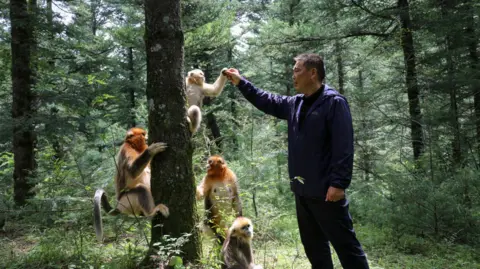Until the 1980s, people roamed the mountains of Shennongjia in central China hunting monkeys for their meat and fur. Poor farmers were still clearing vast areas of trees, and as their environment collapsed around them, so did the local population of golden snub-nosed monkeys, dropping below 500 in the wild.
This was the situation when new graduate Yang Jingyuan arrived in 1991, still in his early 20s. The monkeys' home was being destroyed by logging so their numbers were going down fast, he says. Now it's being protected, and the monkey figures are really improving.
These days, Professor Yang is the director of the Shennongjia National Park Scientific Research Institute and probably no one knows this species better than he does.
He explains that the animals have a complex social structure, where one male may have several wives and their interactions influence the community dynamics. He notes, “The communication has evolved; we understood their sounds mean safety or danger.”
Ranger Fang Jixi reflects on how many struggled financially and were in constant need, leading to a long battle for conservation awareness. As communities became educated on the importance of protecting wildlife, many former poachers became protectors, highlighting the crucial link between local livelihoods and biodiversity conservation.
Today, numbers have rebounded due to a recovery effort, and the hope is to have over 2,000 monkeys within the next decade. Professor Yang expresses optimism about the continuity of these efforts, which are serving as a potential model for conservation in other areas.
This was the situation when new graduate Yang Jingyuan arrived in 1991, still in his early 20s. The monkeys' home was being destroyed by logging so their numbers were going down fast, he says. Now it's being protected, and the monkey figures are really improving.
These days, Professor Yang is the director of the Shennongjia National Park Scientific Research Institute and probably no one knows this species better than he does.
He explains that the animals have a complex social structure, where one male may have several wives and their interactions influence the community dynamics. He notes, “The communication has evolved; we understood their sounds mean safety or danger.”
Ranger Fang Jixi reflects on how many struggled financially and were in constant need, leading to a long battle for conservation awareness. As communities became educated on the importance of protecting wildlife, many former poachers became protectors, highlighting the crucial link between local livelihoods and biodiversity conservation.
Today, numbers have rebounded due to a recovery effort, and the hope is to have over 2,000 monkeys within the next decade. Professor Yang expresses optimism about the continuity of these efforts, which are serving as a potential model for conservation in other areas.





















